Has the Mystery of KV55 been Solved?
Down at the far end of the Cairo Museum is an alcove or small room dedicated to the Heretic Pharaoh. On the right is a huge statue of Akhenaton apparently showing the pharaoh in the nude - but lacking what most men would regard as one of the more important parts of their anatomy. A plinth supports a bust of the pharaoh, whose elongated features show why I refer to him as "Ol' Horse-face". Several glass cases hold objects from Amarna: a statue of Akhenaton kissing one of his daughters rather more intimately that is usual for a father (he ended up marrying a couple of them!), a blue faience hippopotamus, an offering table from which the name "Amun" has been chipped out, and so on.
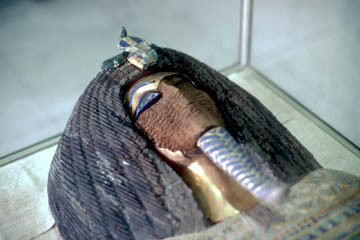
|
| The decayed wood still retains a vague impression of the golden features ripped from the face of the coffin from KV55 |
Just outside the room are another couple of glass cases containing further objects from Amarna. Two hold a collection of the famous Amarna Tablets, cuneiform tablets that formed part of the diplomatic correspondence of the Amarna court. The third holds a spendid mumiform coffin, made of wood and decorated beautifully with multi-coloured stones and glass paste. At first glance it looks as if it came out of the tomb of Tutankhamun. It is a real shock to realise that the golden face is missing, ripped off to expose the decaying wood beneath which still carries a ghostly image of the face. A note beside the coffin simply states that it comes from the Valley of the Kings, tomb 55.
The mystery of tomb KV55 has long intrigued Egyptologists. Situated almost directly opposite Tut's tomb, When it was discovered in 1907 by Theodore Davis, KV55 was a mess, probably due to water getting into the tomb during one of the many flash floods that roar through the valley. The entrance corridor was partially filled with stone chippings on which lay a number of gold-covered boards that almost certainly once formed a "shrine" similar to the one which enclosed the sarcophagus of Tutankhamun.
Thanks to water leaking into the tomb, these had more or less rotted away, leaving only flakes of fragile gold leaf supported by wood as fragile as cigar ash. The archaeologists built a scaffolding platform on which they lay, delicately lifting the gold leaf with tweezers. Thousands of tiny fragments floated in the air and visitors to the tomb recounted seeing the Arab workmen's hair dusted with gold. Only a couple of the boards were in good enough condition to be removed and are now in the Cairo Museum.
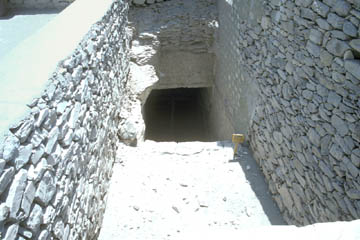
|
| The entrance to KV55, which is not open to visitors. Inside is a single small room badly affected by flooding and therefore dangerous. |
With the gold out of the way the archaeologists were free to turn their attention to the main purpose of a tomb: the burial. The coffin had been placed on a wooden bed, which had collapsed under its weight, spilling the coffin onto the floor and emptying the mummy it contained. It had been further damaged by a slab of rock that had fallen from the ceiling and landed on the lid, splitting it in half lengthwise.
It was once the fallen rocks and flood debris had been removed that the real mystery began to dawn on the archaeologists. The coffin appeared in the classic pose of a pharaoh, with arms crossed across the figure's chest and holes in the hands where the crook and flail should have been placed. This, then, was the burial of a pharaoh.
However when the archaeologists examined the mummy they observed that it had been bandaged and preserved for eternity with one arm straight down by its side and the other placed across the chest. This is the traditional pose for a woman - you can see paintings of similar females clutching a lotus flower all over Egypt. This, then, was the burial of a queen and speculation was rife that it was Nefertiti, the beautiful wife of Akhenaton, though Theodore Davis firmly believed that it was Queen Tiye and announced to the world that he had discovered the tomb of Tiye.
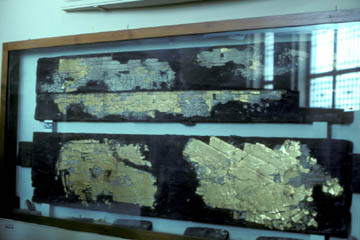
|
| The recovered fragments of gold leaf from KV55 and the fragile wood on which they were mounted in the Cairo Museum. |
Lacking the CT scanners - and the ethics - of today, the archaeologists proceeded to unwrap the mummy. Thanks to the poor conditions in the tomb, the mummy had not survived and all they found were bones - but the bones made it clear that this was the body of a man! This, then, was the burial of a pharaoh - but which one?
The sole clue to the dead man's identity was a cartouche on the coffin which had been carefully and deliberately hacked out. That, and the style of the thing, made it plain that this person was part of the royal court of Amarna. In addition, the name of Akhenaton was found on some objects in the tomb, but in a form which was only used in the early years of his reign. Suggestions that it might be Akhenaton himself were ruled out because the body appeared to be that of a young man, and Akhenaton was thought to have been around 40 when he died.
Various theories were advanced, but the one that appeared to have the most supporters held that this was Smenkare, who may have been a younger brother or even a nephew of Akhenaton. A relief found at Tel el-Amarna shows the older man and his younger companion in such a close juxtaposition that Egyptologists are almost certain that the two had a homosexual relationship. Could it be that Smenkare adopted the feminine role in the relationship and therefore, when he died, was buried in the pose of a woman?
Over the last two years the Egyptians have been investigating all the mummies in their possession using the latest scientific methods of CAT scans and DNA analysis. The results have astounded Egyptologist Albert Zink, director of the Insitute for Mummies and the Iceman at the European Academy in Bolzano, Italy. Speaking of the analysis carried out on the mysterious mummy from KV55 he said, "In the end there was just one solution for this genetic data fitting into the family tree and this showed us this must really be Akhenaten and could not be any other."
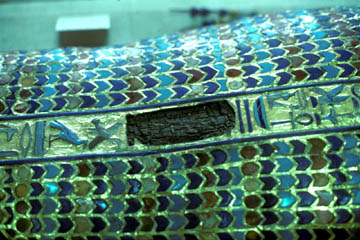
|
| Detail of the coffin showing the deliberately hacked out cartouche which might have contained the name of Akhenaton. |
Some things immediately become clearer - but other mysteries now emerge.
In the first place, the highly specific damage to the coffin is explained, as well as its burial in a relatively insignificant tomb in the Valley of the Kings. Akhenaton had a splendid tomb of his own at Akhetaton, but when the city he founded was abandoned by Tutankhamun, it appears that the royal sarcophagus was removed and brought back to Thebes. (The tomb was vandalised and all references to the Aten were obliterated.) As Tut didn't have time to make his own large tomb, he can hardly be blamed for not having time to make one for his father.
Although the royal mummy was brought safely back to the Valley of the Kings, the cartouche containing the hated name "Aten" was hacked out of the coffin and someone, at some time, deliberately tore off the golden face, effectively leaving the coffin faceless and nameless. Many years later, when the priests removed all the royal burials to the secret cache near Deir el-Bahri, they left the Heretic behind - possibly deliberately.
We know that twelve years before his death Akhenaton had a falling out with his beautiful wife Nefertiti and she went to live in the Northern Palace. The reason for this has never been satisfactorily explained: some have even suggested that the damaged eye in the famous bust in fact represents a physical deformity - perhaps ophthalmia or River Blindness - and Akhenaton, the aesthete lover of the beautiful, could no longer bear to look at her.
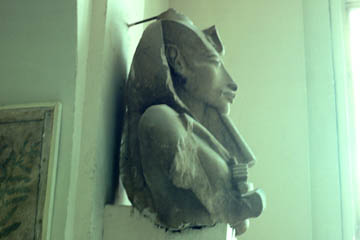
|
| The grotesque features of the Heretic Pharaoh on this bust in the Cairo Museum may have been nothing more than a stylistic fancy. |
Now that we know that Akhenaton was buried as a woman, might it be that the infamous separation was nothing to do with Nefertiti and everything to do with Akhenaton "coming out" in his "true identity" as a woman? Did the Heretic Pharaoh spend the last years of his life as a "queen" and was the much-maligned Smenkare really the male in the relationship? Today, of course, such people head for the surgeon and get "gender realignment" - castration to you and me. Fortunately the state of the mummy means that we will never know if Akhenaton submitted to this ultimate indignity!
However although the bare bones leave us unable to reconstruct Akhenaton's body, they do provide us with some interesting information. Ol' Horse-face's odd appearance has long been attributed to some underlying genetic defect, with Marfan Syndrome being the prime candidate. The DNA analysis conducted by Professor Zink revealed no genetic abnormalities and the bones appear to be those of a man with a perfectly normal shape. In other words, Akhenaton's appearance was a stylistic freak and he no more looked like his statues than Picasso's girlfriend actually had an eye in the side of her head.
In addition the DNA testing revealed something else: a second mummy, definitely female this time, turned out to be Akhenaton's sister - and the mother of Tutankhamun. As the same project has also revealed definite genetic abnormalities in Tutankhamun (as well as traces of malaria) it may be that we have discovered the reason why poor Tut died young: incest is a genetic no-no!
The ultimate fate of Akhenaton's newly identified body is likely to prove as controversial as anything so far. The Egyptian authorities plan to place Akhenaton, his mother Queen Tiye, as well as Tutankhamun's mother, in the museum at Minya. It is a deliberate move to try and bring tourists to what is one of the poorest provinces in Egypt.
Frankly, I am little inclined to support the poor of Minya, who have no one to blame but themselves for their poverty. Asyut and Minya used to be popular tourist destinations because of their proximity to Tel e-Amarna, the amazing cliff tombs of Bani Suef and other important sites. In fact, the Diggings tour used to regularly stay at a hotel in Asyut which was done out like a brothel, with red plush wallpaper as well as furnishings, and mirrors in the ceilings of most bedrooms. It was by no means 5-star, but it was the best in the town!
Just as tourism was really beginning to take off, however, the people of Minya discovered the joys of radical Islam and began to take pot-shots at wandering tourists and even passing cruise ships were hit. Westerners, who have this odd disinclination to be shot, promptly abandoned the area and while the peaceful provinces to north and south prospered and grew rich on the tourist trade, the sullen Islamists of Asyut and Minya grew ever poorer and took out their frustration on the native Christians, burning down their churches and murdering them in the fields with the tacit acquiesence of the local police.
Never mind the tourists - I would have thought Akhenaton himself would be in danger from these brainless fanatics (witness the Bamian Buddhas), unless, of course, someone has the bright idea of informing the mad mullahs that as Egypt's first monotheist, Akhenaton was really a prophet of Allah and his remains are to be respected. With any luck, if I do decide to visit, I'll find the museum crowded with Sayyids in green turbans come on pilgrimage to the shrine/museum and Queen Tiye's display case hung with scraps of cloth left there by barren women or those unfortunate enough to have given birth to daughters.
a ghostly image In fact the face was much clearer when the coffin was first discovered, as can be seen in photographs taken at the time. Since then the wood has decayed badly, leaving only the impression of a face which can be seen in the photograph in this article. Unfortunately, it is unlikely that the face was that of Akhenaton: the coffin appears to have been made for a woman, even though the pose is that of a man, for the inscriptions on it bear clear signs that the feminine words have all been altered to the masculine forms. Return
© Kendall K. Down 2010





